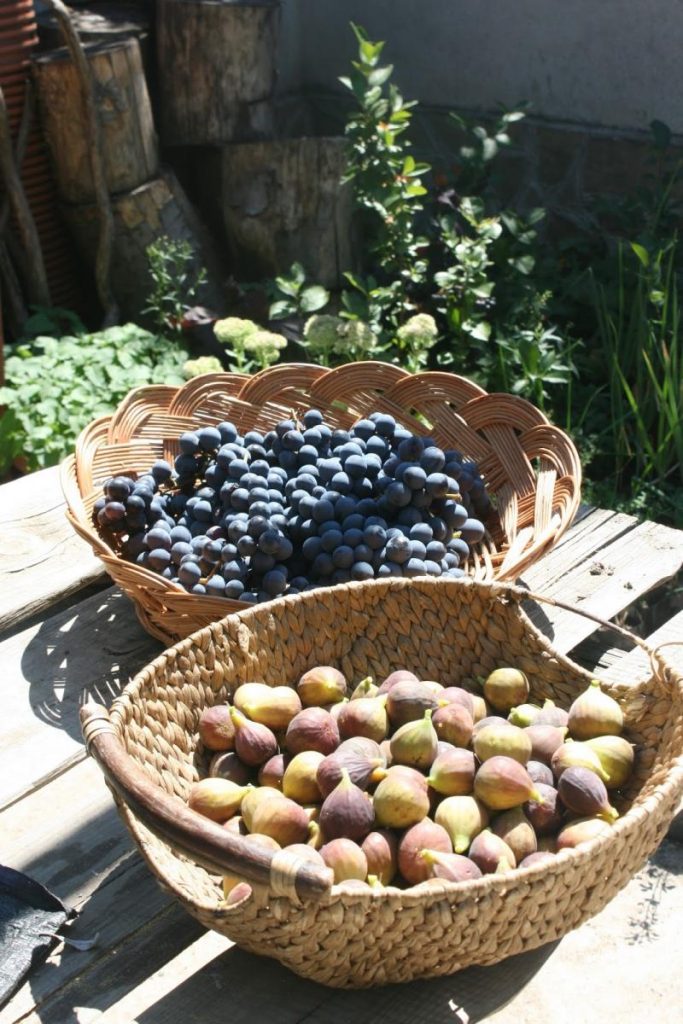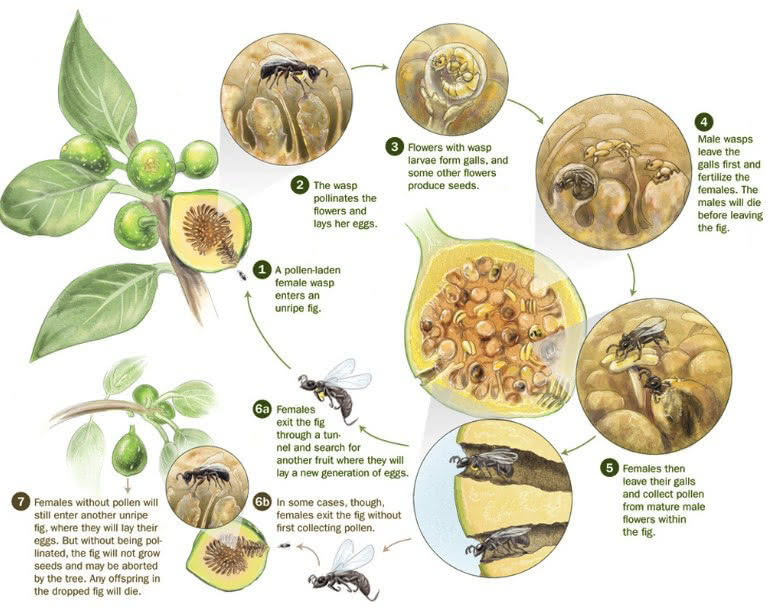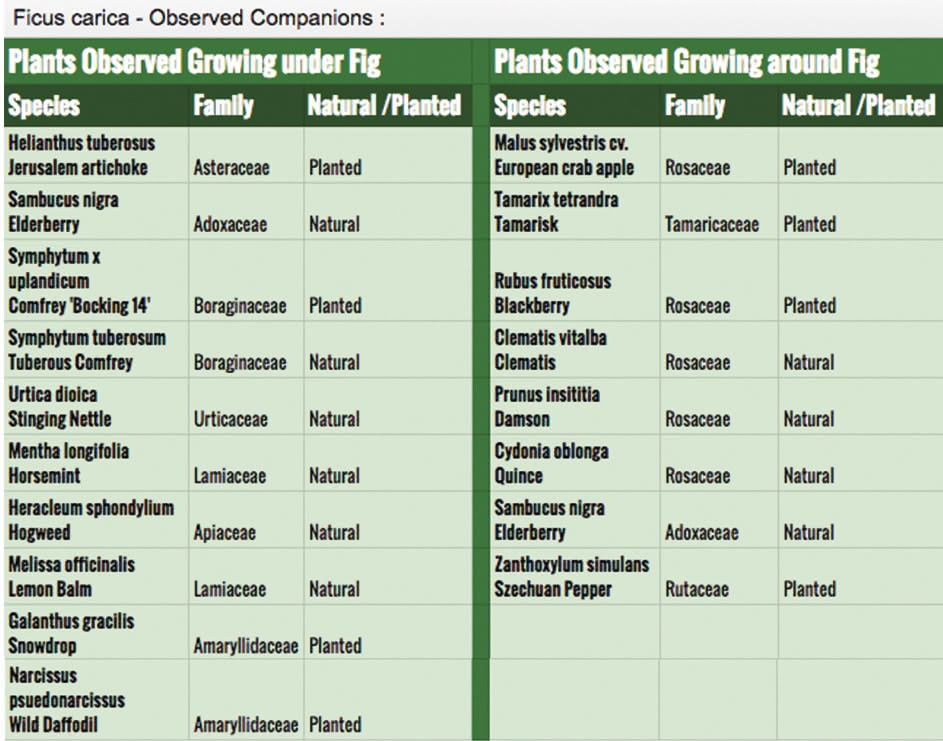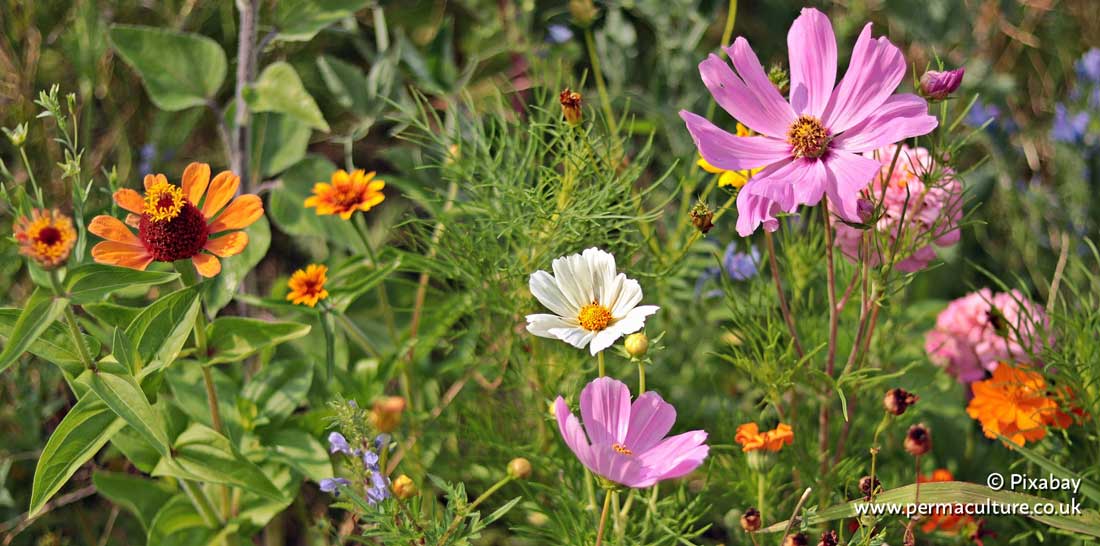Originally from Asia Minor, the fig is probably the oldest cultivated fruit in the world. There is evidence to suggest that some 10,000 years ago some of us were planting figs directly outside our caves presumably to be able to slip out for a figgy delight without worrying too much about getting torn to shreds by a sabre tooth tiger.
Man and fig have come a long way since then but have remained very much good friends, travelling and setting up home together all over the world where summers are warm and dry and winters are cool. During this article we’ll be focusing on the common fig – Ficus carica. We’ll look at fig types, hardy figs, fig cultivation, fig reproduction, fig propagation, good companion plants for figs, and growing figs commercially.
Latin name – Ficus carica
Common name – Common Fig – Adriatic Fig – Symrna Fig
Family – Moraceae (same family as Mulberry)
Native range – A temperate species native to southwest Asia and the Mediterranean region (from Afghanistan to Portugal).
Description – A tall deciduous shrub or small tree reaching a height of about 10m. Single or multi stemmed.
Uses – The fruit is eaten fresh, dried in confectionery, brewed as an alcoholic beverage or used as a laxative. The fruit is a source of calcium, sugar, iron, copper, carbohydrates, potassium, and vitamin A. The leaves are used as potherbs or fed to livestock. The tree is also grown for shade and has value in the ornamental garden.
Growing period – The fruiting cycle is 120-150 days. Some varieties produce one crop per year, others two. Trees have been known to live as long as 200 years.
Growing conditions – Fig thrives best in areas of moderate relative humidity and can be grown at higher elevations in areas of low rainfall. Fig requires some dry months particularly at the flowering and fruiting periods and requires some winter chilling. They are light demanding plants and will grow best with eight hours or more of direct sunlight. Fig can grow in virtually any soil type but prefer a sandy-clay loam within a pH range of 6.0 to 8.0 tolerating soils with high lime content. A soil depth of 1-1.5m is sufficient for growth. Figs can also grow in rocky areas from sea level to 1,700 meters.
Growing behaviour – Figs are a shallow fibrous rooted species, although depending on location, the roots may spread laterally and vertically. Figs may have single stemmed tree like growth or multi-stemmed shrub like growth and often send up suckers from the base of the tree and spreading root system. Fig wood is weak and decays rapidly. The leaves emerge in late spring and in our climate drop shortly after the first frost in late autumn. Fig fruit is borne on the spring new growth.
Fruit – Fruits generally ripen from August – October depending on cultivar and climate. Some trees produce what is called a breba which are fig fruits that develop in the spring on the previous year’s shoot growth, followed by the main fig crop that develops on the current year’s shoot growth and ripens in late summer or fall. In cold climates the breba crop is often destroyed by spring frosts.
Ecology – Fig fruit is an important food source for much of the fauna in some areas, and the tree owes its expansion to those that feed on its fruit. Seed is dispersed by birds and mammals that scatter the seeds in droppings. We often find various bees and wasps feeding on openings in the fruit made by birds. We’ll leave some of the fruit on the tree for other organisms and always have plenty of figs.
Figs can be divided into four distinct categories
Within these categories one can find over 750 cultivars! The fig contains more naturally occurring varieties than any other tree crop.
Fig cultivars/varieties – Fig cultivars have many unique characteristics such as compact to spreading growth habits, fruit colour, shape, taste and size, plant hardiness etc.
Cold hardy fig cultivars – Although often considered a Mediterranean plant there are many figs that have been cultivated to withstand cold climates in some cases withstanding winter lows of -20oC.
Young figs are more sensitive to cold winters than larger figs so it’s best to over winter young plants perhaps even grow on in a pot until a good root system has established especially if you are growing fig on the limits of the climatic conditions they are accustomed to.
According to some sources, figs less than two to five years old are likely to die back to the ground during very cold winters. Very wet winter soils make a fig more likely to perish. Good site selection and soil preparation along with a generous winter mulch can go a long way to prevent this.
It’s possible that one of the hardiest figs on the planet was developed here in Bulgaria. A cultivar named ‘Michurinska 10’ is commonly grown here at altitudes above 1000m elevation in areas that receive extreme winters lows of below -20oC.
The fruits are small but numerous and sweet when ripe which can be from early as late August through to early October. In a hot dry summer, the fruits can be left on the tree to dry and keep well into the winter. Picking them ripe, splitting them in two and leaving in the car, parked in the sun for a few days is also very effective.
The hot long summers here ensure a good reliable crop from these plants each year. From time to time when we have a very cold winter, the top growth dies back but in the spring new growth arises from the base of the plant and can produce a good crop of figs that same summer. Around 30-50 stems may come up in the spring and we found it good practice to remove at least 50% of the new growth before fruit sets and then thin down to no more than 8-10 of the best stems in the autumn after a harvest.
We’re also growing ‘Izmir’ a Turkish cultivar.
We grow a range of hardy fig cultivars from our bionursery. You can find more info on our hardy cultivars below.
For a list of other cultivars suitable for growing in temperate climates with cold winters, see here.

Where to plant your fig – Figs require full sun all day to ripen palatable fruits. Some cultivars can become enormous, and will shade out plants growing beneath so select a site that the tree can grow into. Trying to reduce size by pruning the branch length causes loss of crop.
Figs can be successfully grown in pots and this will moderate the plant size. For container grown plants, replace most of the soil in the tub every three years and keep the sides of the tub shaded to prevent overheating in sunlight.
In areas with short (less than 120 days between frosts), cool summers, espalier trees against a south-facing, light-colored wall to take advantage of the reflected heat. In coastal climates, grow in the warmest location, against a sunny wall or in a heat trap.
Fig root invasiveness – Fig tree roots generally are very invasive, although much depends on the cultivar, its planting location, and the overall soil quality. Most fig trees, if they are planted in optimal conditions, spread their roots far and wide and sometimes the roots can choke out other plants and can damage sidewalks, driveways and other objects in their paths. Fig trees usually do best on the outskirts of a garden or surrounded by plenty of open space. In order to minimize root invasion some growers will plant trees in pots or build underground retaining walls to keep the roots structured.
Celeste or Malta fig trees typically keep their root systems more or less contained, larger trees such as the brown turkey fig trees have more of a tendency to dominate a space.
Fig pruning – Pruning is recommended only during the initial years. Trees should be trained according to use of fruit, such as a low crown for fresh-market figs. Since the crop is borne on terminals of previous year’s wood, once the tree form is established, avoid heavy winter pruning, which causes loss of the following year’s crop. If a mature tree has died back during a cold winter the following spring will bring many new shoots and we have found it good practice to thin these out to all but 10-12 stems. Further thinning (of the now bush like plant) will help improve access, air circulation and will result in fewer but higher quality fruits. We remove any mature stems that are touching each other or appear crowded.
Fig branches and leaves contain a milky sap that is irritating to human skin so when pruning and harvesting it is good to wear gloves.
Irrigation requirements – In most Mediterranean countries figs are grown as rain-fed but the most critical period of irrigation is early spring before rapid shoot and fruit development. Around 750mm of annual rainfall is considered sufficient to produce a good crop. Rain or heavy irrigation during fruit development and ripening can cause the fruits to split.
Harvesting figs – Figs must be allowed to ripen fully on the tree before they are picked. They will not ripen if picked when immature. A ripe fruit will be slightly soft and starting to bend at the neck. Harvest the fruit gently to avoid bruising. Fresh figs do not keep well and can be stored in the refrigerator for only 2-3 days. Some fig cultivars are delicious when dried. They take 4-5 days to dry in the sun and 10-12 hours in a dehydrator and around two days on top of the car dashboard (parked in a sunny spot). Dried figs can be stored for 6-8 months.
Care and Maintenance – We have found our figs to require very little care. In the past we have added 20 L of mature compost to the base the trees and mulched with a bale of straw before winter. Our trees are located next to the veggie garden and another next to a chicken run so I assume they forage for the nutrients they need from those spaces.
Pests and diseases problems – Problems are mainly encountered when trees are under stress and good practices will prevent most problems. We have never experienced any disease or pest but do lose some of the crop to birds.
In some cases, a young, healthy fig tree undergoes proper pollination and fruit set, then drops all its fruit suddenly. This phenomenon is usually caused by overfeeding. It may take three to four years for the fig to recover from over-fertilisation and produce a crop that ripens and stays on the tree. Avoid using shop bought liquid feeds, instead use good compost fed at the base of the plant (20 L in the spring) and you should not experience this.
Figs are generally propagated by cuttings and for commercial plantations by tissue culture. We have had success with hard wood cuttings taken in late autumn/early winter planted inside and outside into a free draining medium (50% river sand 50% sieved compost). We’ve also had good results from division (digging out sections of the root system that has sent out new shoots) and layering. The key to success is to water the cuttings well during dry periods. Another good method that can be practiced at anytime of year is taking 15cm cuttings of second year growth and placing then in 10cm of water. Clean the water when it starts going green (every 5-7 days) and plant out when a good root system starts to form.
Fig pollination is fascinating but not great news for fig loving vegetarians.
What we call the fig fruit is actually a flower or to be more precise an inflorescence – a cluster of many flowers and seeds contained inside a bulbous stem. Because of this unusual arrangement, the seeds –technically the ovaries of the fig – require a specialized pollinator that is adapted to navigate within the fruit and here begins the story of the relationship between figs and fig wasps.
The queen of the fig wasp is almost the perfect size for the job and enters through a tight opening in the fig called the ostiole.
Once inside, the queen travels within the chamber, depositing her eggs and simultaneously shedding the pollen she carried with her from another fig. This last task, while not the queen’s primary goal, is an important one: she is fertilizing the fig’s ovaries. After the queen has laid her eggs, she dies. Once the queen’s eggs hatch, male and female wasps assume very different roles. They first mate with each other and then the females collect pollen while the wingless males begin carving a path to the fig’s exterior. This activity is not for their own escape but rather to create an opening for the females to exit. The females will pollinate another fig as queens. The males will spend their entire life cycle within a single fruit.
Bad news for vegetarians thus being when you eat fig you probably eat wasp, however, common fig types have all female flowers that do not need pollination for fruiting as the fruit can develop through parthenocarpic means. Black Mission, Brown Turkey, Brunswick, and Celeste are some representative cultivars.

The fig tree, having an extensive shallow root system and in maturity casting a heavy shade, generally inhibits the growth of plants directly growing under the crown. Over the years, however, I have observed the below list of plants growing along with the fig, some of which we planted, others naturally occurring.
I leave our fig trees to branch low to the ground for ease of picking the fruits. This results in a very deep shade cast under the plant and as a result the comfrey and artichoke produce little biomass in the summer. Under plantings do grow well before the fig leaves emerge in late spring, tuberous comfrey in particular forms a dense mat and flowers profusely before dying back during the summer when the fig is in full leaf.
When companion planting with fig, it is best to select early flowering plants that yield before May and can tolerate deep shade during the summer months. We have experimented with bulbs (included below) that utilize nutrients during the dormant season, provide early nectar and pollen to bees and other pollinators, and provide beauty contrasted against the grey frame of the winter fig.

We are not growing figs commercially and have no experience of this. The below info is largely taken from online resources.
Orchard establishment – Figs are planted in winter and early spring. Spacing depends on the variety chosen. The average planting density is 3 x 4m or 833 trees per hectare. In Valinhos, Brazil, recent experiments placed 2,666 trees on a hectare.
Figs respond well to organic matter and in most countries well rotted farmyard manure is dug into pits before planting. At least 20 L are added per tree.
Caprification – In orchards requiring caprification, the male trees are grown in an area separate from the orchard. One male tree is required for every 50 female trees. The male figs are hung in stretch poly bags in trees in the orchard when figs reach button size.
Irrigation – Depending on soil types and farmers’ preferences, sprinklers and drips are used. The equivalent of 750mm annual rainfall is sufficient to produce a good crop.
Drying figs – Dried figs are allowed to ripen on the tree and then dried for between 3-4 days depending on the area. Figs can actually dry on the tree as is the case in Turkey, Iran, Greece and the U.S.A. where after they fall to the ground and are then vacuumed up.
Pests and diseases – Fig stem borer, mealy bugs, fruit fly, aphids and scale are all insects which can affect the health of a tree and rust, mosaic virus and endosepsis are the main diseases seen in figs. These problems are mainly encountered when trees are under stress and good orchard maintenance will prevent most problems.
Soil cultivation – Although figs tolerate different soil types they are more productive in soils with a sandy-clay loam profile. A depth of 1.5m is sufficient for root development but water logging will adversely affect growth and productivity. The ideal pH range is between 6 and 8. When planting many figs testing should be done for root nematodes that are known to affect figs.
Fertilisation – Figs can perform well under soil conditions unsuitable for other crops but recent studies prove that nutrients exert an effect on yield and quality. Nutrient requirements differ according to variety but leaf analysis will indicate fertilizer requirements. Drying varieties are more sensitive to nitrogen and adversely affect fruit size and colour. Too much nitrogen also affects the breba crop adversely. A good application of compost (20-40 L under a mature tree 10-20 for young trees) along with regular comfrey mulching should be sufficient fertiliser for your fig trees
Pruning – Along with fertilization this has become one of the most important tools in the modern orchard. In Japan most orchards are trained for two metres, 400mm from the ground. New shoots train onto a trellis of two metres in height which allows for easier picking. To provide for more early or breba crops summer tip pruning is done. Timing of pruning can play an important role in determining later picking/ripening of fruit.
Harvest – Figs are harvested when ripe as ripening does not advance after picking. Depending on the area, summer fruits will start ripening towards the end of August and depending on the cultivar will continue for between 4-8 weeks until the end of October. At the start of ripening, fruit is picked every three days increasing in frequency to every day when the harvest is at its peak and reducing to every third day as the harvest tails off. Harvesters can usually pick about 100 fruit per hour.
Figs for shipping are collected daily just before they reach the fully ripe stage, but yield to a soft pressure, usually indicated by small cracks in the skin. They should be immediately refrigerated. For commerce, choose a cultivar that parts readily from the branch and does not tear the neck.
This post originally appeared on the Balkan Ecology Project website at: http://balkanecologyproject.blogspot.co.uk/2016/09/dig-fig-essential-guide-to-all-you-need.html
Paul runs the Balkan Ecology Project in Bulgaria with his wife Sophie Roberts and their two boys Dylan and Archie.











